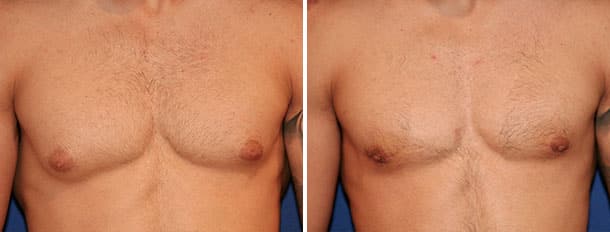A body feature that is admired on a woman is an embarrassing feature that can develop in some men over time: breasts. Often not talked about, many men are insecure about enlarged, female-like breasts that are characteristic of a condition known as gynecomastia. Even with a healthy diet and exercise plan, excess glandular tissue and fat are often unresponsive to traditional weight-loss methods. Many men have tried exercise, diet, and medications that promise to get rid of their enlarged breasts to no avail. Male breast reduction, or gynecomastia surgery, is an ideal procedure designed to remove overdeveloped or enlarged male breasts.
Schedule Your Consultation TodayAchieved With Gynecomastia Surgery

ELIMINATION OF GLANDULAR TISSUE
Gynecomastia is characterized by a buildup of excess glandular tissue in the chest area. When performing a male breast reduction, Dr. Taylor will remove the excess fat and glandular tissue that causes the unflattering appearance of enlarged male breasts.

A MORE DEFINED CHEST
The word “breasts” is generally viewed as a feminine term. Men who suffer from gynecomastia feel as if they have developed a female trait that makes them appear less masculine. The goal of gynecomastia surgery is to provide a more firm, muscular appearance. Dr. Taylor will sculpt and drape the tissue over the pectoral muscles to create a stronger, more defined chest appearance.

INCREASED COMFORT
Some men choose to undergo male breast reduction surgery not because their gynecomastia is unflattering but because having excess glandular tissue and fat can be uncomfortable and painful, especially during physical activities. Dr. Taylor will remove excess fat, glandular tissue, and skin to help a man feel more comfortable in his body.

RESTORED CONFIDENCE
Many men who have male breasts avoid situations that require them to remove their t-shirt or wear tight-fitting clothing. They are insecure about how their body looks bare or how it appears through clothing. Once the chest contours have been reduced and shaped into a more attractive, masculine appearance, many men are more confident about how their body looks. Some gynecomastia patients can’t wait to show off their newly shaped muscular chest after the procedure.
What Does Gynecomastia Surgery Entail?
PROCEDURE
Before surgery, medication is administered to increase patient comfort. Gynecomastia surgery is performed with general anesthesia, intravenous sedation, or for smaller cases, local anesthesia alone. An incision is made near the breasts, and fat is removed using liposuction. For the liposuction procedure, Dr. Taylor inserts a thin, hollow tube (cannula) and uses a back and forth motion while the fat is suctioned out through a vacuum. If necessary, Dr. Taylor makes an incision around the nipples to remove excess glandular tissue. The incisions are closed using surgical tape or sutures. Typically, the procedure takes one to two hours.
RECOVERY
Patients can return home following the procedure. Dr. Taylor will provide patients with postoperative instructions to ensure the swiftest, most comfortable recovery. A support garment may be used to reduce swelling and support the chest contours. For the first few days, patients should rest and refrain from strenuous activities, especially those that involve the movement of the arms and elbows. Most patients can return to work in several days and can resume vigorous physical activities in two weeks.
SCARS
If the patient only required a small scar for liposuction, it will gradually fade and eventually become unnoticeable. If tissue excision was used during surgery, patients will have a scar around the areolas that fades away over several months.
COST
The cost of gynecomastia surgery will be determined based on the technique used, geographic location, and the surgeon’s experience. Dr. Taylor has more than 20 years of experience performing plastic surgeries such as male breast reduction and liposuction. He has the passion and skill to provide you with the care and attention needed to achieve satisfying results.
PAIN
Throughout the years, advancements in gynecomastia surgery, such as safer liposuction methods, have made undergoing this procedure an easier experience. Some patients may experience discomfort following the procedure. Dr. Taylor will administer medication before the surgery and prescribe oral pain medication to help to create a comfortable and smooth surgery and recovery experience.
FAQs
What is gynecomastia?
Gynecomastia is a condition characterized by localized excess fat, excess glandular tissue, and excess breast skin that can occur unilaterally (in one breast) or bilaterally (in both breasts). This condition can affect men of any age. Gynecomastia often develops due to hereditary factors, obesity, hormonal changes, the use of certain drugs and medications, impaired liver function, or medical problems.
Who are the best candidates for gynecomastia surgery?
Men who have tried diet, exercise, or medication to get rid of gynecomastia with no success are ideal candidates for gynecomastia surgery. It is important that patients have breast development that is stabilized and that they are at or near their goal weight. Men undergoing surgery should be in good health, not smoke, and have realistic expectations.
Can gynecomastia surgery be combined with other plastic surgery procedures?
Gynecomastia is commonly performed using liposuction. It can also be combined with other body contouring surgeries, such as body liposuction, tummy tuck surgery, and arm lift surgery.
How long will my results last?
Results achieved with gynecomastia surgery are permanent. However, weight gain and certain steroids or medications can cause the recurrence of gynecomastia. For the best outcome, patients should maintain results by practicing a healthy lifestyle and incorporating diet and exercise into their daily routine.
What are the risks and complications associated with gynecomastia surgery?
Although rare, some risks and complications are associated with gynecomastia surgery, such as:
- Bleeding
- Infection
- Breast asymmetry
- Poor wound healing
- Unfavorable scarring
- Anesthesia risks





